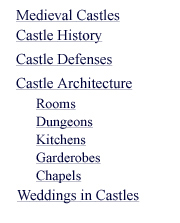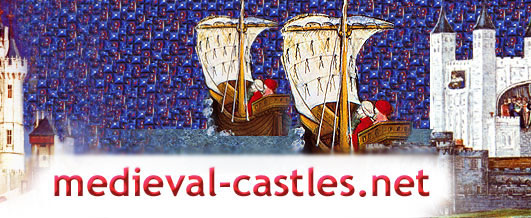Castle Architecture
Bedrooms,
Bathing,
and what did they do without
indoor plumbing?
Solars and Squints
Castle lords and ladies generally lived
in the upper stories of the keep in a room called a solar.
These might be divided with partitions, but the main feature
of the room would be the bed. The lord's bed would be made
with a heavy wooden frame and have a canopy that would be
pulled back during daylight hours. Comfort was provided with
feather mattresses and springs made from interlaced ropes
or staps. These beds would be dismantled taken with the lord
when he traveled.
Lords and ladies might have kept separate
chambers, each accompanied by their attendants who would sleep
on palettes, benches, or small mattresses on the floor.
Medieval furniture included intricately
carved wooden chests for clothing and wall pegs to hang robes.
A small stool might have been in the room to be used while
dressing. Armchairs became popular in the late Middle Ages.
Castle guests, the lord's eldest son and
the castle steward would occupy chambers on higher levels.
These rooms would be equipped with peepholes calls squints
that were used to monitor the activity below.
Tubs and the Bathman
Bathing was done in wooden tubs padded
with cloth. Privacy provided by tents or canopies. When the
lord traveled, the tub traveled with him, maintained by a
bathman who was also responsible for heating the water. In
warmer weather the tub might be placed outside near the garden
while during the winter the bathing would be done close to
a chamber fireplace.
Some castles in the late Middle Ages engineered
hot and cold running water to certain rooms in the castle,
but these were rare. Other castles had permanent "bath
rooms" with tiled floors.
Medieval Garderobes and Gong Farmers
Even the grandest castle didn't have bathroom
facilities. Usually latrines or garderobes would
be built into a castle wall overhanging the ground or water
below. Some garderobes had wooden seats but many were simply
carved into the castle stone. These could be quite uncomfortable,
especially in the winter! Iron bars were placed on some garderobe
chutes to keep invading armies from using them as a point
of entry.
Garderobes would be placed near bedchambers
and other parts of the castle, some partitioned with screens
for privacy, but many were rather exposed. Chamber pots were
popular throughout the Middle Ages and straw was used as Medieval
toilet paper. Larger castles had dedicated latrine towers,
and the person with the unsavory job of emptying the latrine
was called a gong farmer.
|










